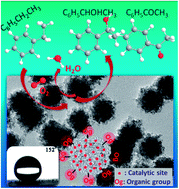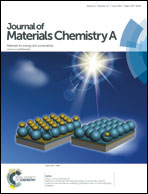Superhydrophobic SiO2-based nanocomposite modified with organic groups as catalyst for selective oxidation of ethylbenzene†
Abstract
A surface organic modification strategy is utilized to design and prepare a series of superhydrophobic SiO2-based nanocomposites with cobalt ions in the bulk phase and different organic groups on the surface. Physical properties such as BET surface area, surface hydrophilicity/hydrophobicity, and water adsorption amount changed significantly with the introduction of organic groups of various chain lengths, which was confirmed by TEM, SEM, FTIR, 29Si-NMR, N2 adsorption–desorption, sessile water contact angle, and TG-DTA measurements. Surface hydrophilicity/hydrophobicity altered from hydrophilic to superhydrophobic with an increase in carbon chain length, which showed an obvious effect on the catalytic performance in selective oxidation of hydrocarbons such as ethylbenzene. Superhydrophobicity was guaranteed for high catalytic activity, and the carbon chain length of the organic group was also an important factor. Superhydrophobic Pr–Co–SiO2 that contained the propyl group was the most efficient catalyst, and the conversion of ethylbenzene reached 70.4% with O2 as an oxidant under solvent-free conditions at 393 K for 7 h, which is nearly nine times that of the hydrophilic Co–SiO2 without surface organic modification.


 Please wait while we load your content...
Please wait while we load your content...